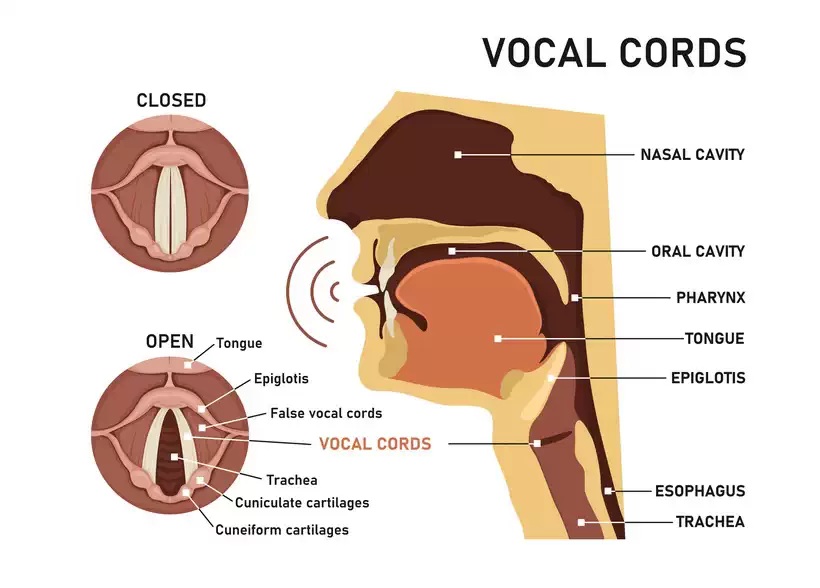To many people, being able to produce vibrato is part of having a great singing voice. Of course, so is knowing when to use chest voice and head voice.
Do great singers have a natural vibrato? How do your vocal cords even produce it? In this list, we’ll take a closer look at vibrato singing.
Vibrato Singing: A Beginner’s Guide
1. What Exactly Is Vibrato?

What does it mean to sing vibrato? Essentially, vibrato means a rapid, even variation of pitch. You might also hear it described as an oscillation of pitch. It usually happens on sustained notes.
If you’ve heard a violin vibrato, a singer’s vibrato is similar. But while you need a specific vibrato technique to produce vibrato on a violin, a vibrato voice is produced with the vocal cords.
More specifically, the vocal cords vibrate as you sing, producing the vibrato voice. That means that in order to produce vibrato, you need to be able to relax your entire vocal tract (including vocal cords and vocal folds). Contrary to popular belief, natural vibrato is not jaw movement, and it is not only produced within a high vocal range. Check out this video if you want to see some examples of famous singers with incredible vibrato.
2. The Three Components Of Vibrato
Singing without a vibrato effect is called “straight tone.” But interestingly enough, research has determined that there is no true “straight tone” when it comes to the human voice; there is always some pitch variation due to the nature of the vocal tract.
But before we jump into the vibrato technique, it’s important to understand that a natural vibrato has three central components: pitch, volume, and timbre.
The one that immediately comes to mind is pitch. After all, singing vibrato essentially means a variation in pitch. But how much is that variation?
The moderate vibrato used by most singers involves the pitch wavering by about a quarter step on either side of the note. That wavering is caused by the vibration of the vocal cords and vocal folds. So as you might expect, the pitch wavering is pretty fast; it’s about 5-8 oscillations every second!
Of course, the volume also comes into play. This refers to the note’s particular intensity. Some singers opt to use vibrato on the louder, sustained notes of a song. Others use a lower-volume vibrato to create warmth and texture to softer vocals.
That brings us to timbre, an important characteristic to take into account when working to sing vibrato. Timbre refers to character and tone. Some singers prefer to produce vibrato that is powerful and has a sharp attack. Others prefer a mellower, warmer sound.
Of course, your unique vocal tract determines some of the timbres of the notes you sing. But as you learn how to better use your voice, you’ll find that you have some control over the exact timbre of the notes you sing. To learn more about vibrato and what makes it happen, check out this cool video!
3. Vibrato vs. Vocal Trill

The vibrato sound is a distinctive one thanks to its rapid yet slight pitch variation. But to the untrained ear, it may sound like a vocal trill.
A vocal trill does have a vibrato-like sound, but there is a key difference between the two. When you’re singing vibrato, your voice is wavering in pitch around a single note. A vocal trill moves back and forth between two separate notes.
Vocal trills are a good bit harder to do. You may sometimes hear opera singers perform them. The good news is that since trills are usually harder, it’s unlikely that you’ll accidentally do one when you’re trying to sing vibrato. Still, if you want to challenge your vocal cords, you can work on learning to do vocal trills, too. This video talks you through how to do trills.
4. Vibrato vs Vocal Wobble
Lots of singers are in a hurry to produce a great vibrato sound. But as you’re working to produce vibrato, be wary of the vocal wobble. A vocal wobble sounds like an excessively slow vibrato with an overly broad pitch variation.
Usually, a vocal wobble is caused by a lack of muscular support in the body. That means that your abdominal and lumbar muscles aren’t correctly creating breath support. In some cases, a wobble is created or made worse by the fact that a singer is using muscles in the larynx that shouldn’t normally be used in singing.
This effect may also happen when your vocal cords are overly relaxed. It sometimes happens when a singer gets older and loses some muscle tone. It also can show up in singers who drink excessively, as alcohol can make the vocal cords too relaxed as well.
If you’re working to develop vibrato in singing, be careful that you aren’t accidentally cultivating a wobble! If you still aren’t quite sure what a wobble is, this video illustrates the vocal wobble in opera singers. If you aren’t sure whether you’re singing vibrato or singing with a vocal wobble, try recording yourself as you practice.
When you play it back, you will get a clearer idea of how you sound. This article goes into some more depth on the causes of the wobble and some vocal exercises on how to fix it.
5. Vibrato vs “Gospel Jaw”
If you’re new to the vibrato technique, you might think that the vibrato effect is created by moving the jaw quickly. You don’t need to move your jaw to produce vibrato, but there’s a reason many people think you do.
That all started with something called “gospel jaw” or “jaw vibrato.” You can see that when Whitney Houston sings. This technique sometimes does create a simulated vibrato, but it’s typically adopted by gospel singers to emphasize the high notes in a song where vibrato is used.
In other words, the jaw vibrato is more of a theatrical technique than a practical one. Thanks to the widespread use of gospel jaw or jaw vibrato, plenty of people believe that rapid jaw movement is the key to vibrato. But with proper vibrato technique, you don’t need to make any appreciable jaw movement. If you aren’t really sure what jaw vibrato is, this video shows you a clear example.
6. Singing With Vibrato: Posture

You probably already know that good posture is essential to good singing. So it stands to reason that it’s important to use it when producing vibrato. If you regularly use poor posture when singing, it can cause more problems than just making you look bad. Chronically bad posture can lead to vocal tension, which can then lead to vocal strain or even injury.
So what does good posture look like for a vocalist? Start by standing up straight but without locking your knees. Keep your shoulders back and your chest pushed slightly outward.
The key is to stand up straight without being too tense. Have your feet slightly apart with one a little in front of the other. You’ll want to have your weight slightly forward. Keep your chin approximately parallel to the floor.
That will help keep your airway open and make your vocals sound as good as possible. After all, if you want to be able to sing vibrato well, you need to be able to sing comfortably and without vocal strain. If you want to improve your head voice and chest voice while also developing a great natural vibrato, check out this useful video on singing posture.
7. Singing With Vibrato: Breathing

Whether you prefer to sing breathy or not, breathing is essential for good vocal technique. You of course need to make sure your vocal folds and the rest of your vocal tract stay relaxed. But that’s only one part of creating a natural vibrato voice!
If you’re already familiar with the singing techniques, you’ve probably heard of “breath management” or “breath support.” If you want to maximize your vocal range as well as get the best tone you can out of your head voice and chest voice, managing your breath is a must.
To sing vibrato (or sing at all), you need to control the amount of airflow coming from your lungs. While you need to take rapid breaths that fill your lungs with air, you also need to release the air in a slow, sustained manner to produce sound.
To get a sense of what this feels like, you can practice it without even singing. Take in a deep breath, making sure that your abdomen expands outward rather than upward. Then, gradually exhale. At first, exhale for 5-10 seconds. As an exercise to improve your breath support, you can work on making the exhale last even longer.
When you inhale, it also can be helpful to practice something called combined breathing. This is where you inhale with your nose and your mouth at the same time. Though it sounds strange, it actually has some benefits.
If you breathe only through your nose, you won’t get enough air to fill your lungs all the way and support higher notes.
Breathing in through your mouth gives you enough air for vocal power. But if you only breathe in through your mouth, your throat can dry out and your vocal cords can become strained. When you use both methods to breathe in, you get the best of both. If you want to learn some useful breathing exercises for singers, check out this useful video.
8. Singing With Vibrato: Using Your Diaphragm
If you’ve ever taken singing lessons, you know just how important your diaphragm is. But what exactly is the diaphragm? It’s a muscular sheath that sits below the lungs. It “flattens” or contracts when you breathe in to draw air into the lungs and relaxes to push air out.
When you think about breathing from your diaphragm, you draw in enough air that the air pressure from your lungs can support the small amount of air you exhale on each note. This is especially crucial on sustained notes (the ones where you normally hear natural vibrato). When you maintain sufficient air pressure via your lungs and diaphragm, you will be more likely to stay on pitch.
Many tutorials designed to help you learn to sing vibrato will mention “singing from your diaphragm.” It’s important to note that you technically don’t sing from your diaphragm; you sing from your vocal cords. But if you practice maintaining proper breath support, it will feel like you’re singing from your diaphragm. This interesting video guides you to use your diaphragm as you sing.
9. Can Vibrato Really Be Learned?
Just about all great singers use a vibrato sound at least some of the time, especially on a sustained note. So if you can’t sing vibrato right away, you might start to wonder if it’s natural or learned.
The truth is that with solid vocal technique, vibrato will develop naturally. You will need enough breath support to create sufficient air pressure. But at the same time, your vocal cords must be relaxed enough to vibrate freely. Usually, vibrato will appear naturally if you take great care to perfect your vocal technique.
If you’re relatively new to singing, you may accidentally be tensing your entire vocal tract. In some cases, you can get so focused on using your diaphragm for support that you overly tense your whole body.
Do your best to maintain a good singing posture while keeping your mouth & throat relaxed. As a side note, some people try to mimic vibrato by making their voices waver. Don’t do this! It will sound artificial. It also necessitates a lot of tension and can lead to a vocal injury. If you want to start discovering or developing vibrato, this video can help you do it.
10. Learning Vibrato: What Not to Do

Whether you’ve developed vibrato in singing already or are still working toward it, working on your technique is always a good idea. Doing proper vocal exercises consistently is great. But as you learn to sing vibrato, it’s a good idea to be mindful of what to avoid.
When developing your singing technique, make sure you avoid creating false vibrato. One of the most common types is diaphragmatic vibrato. Diaphragmatic vibrato is created when you very quickly press up and down on your abdomen (about where your diaphragm is) while holding a sustained note.
This will create an uneven sound that might mimic vibrato, but a diaphragmatic vibrato just sends bursts of air through your vocal cords. Some tutorials recommend doing this as a start. But since it uses an entirely different mechanism from a true vibrato, diaphragmatic vibrato is something you should generally avoid.
As you learn to sing vibrato, you’ll want to avoid the “gospel jaw” method mentioned above. Though it’s possible to move your jaw enough that you create a vibrato-like sound, doing this will cause a good bit of vocal tension on top of sounding unnatural.
And lastly, make sure you avoid what some people call “laryngeal vibrato.” This one looks ridiculous: it involves shaking your larynx with your hand while holding a note. Like the other methods, it can cause some pitch variation in your singing voice, but it is not a genuine vibrato!
In short, the best way to learn to sing with vibrato is to perfect your singing technique. In time, you’ll develop a quality, natural vibrato that sounds a whole lot better than the shortcuts do. For some guidance on other vibrato mistakes many singers make, check out this great video (below left).
Additionally, these videos (above right) offer some quick daily exercises to help you achieve (or improve upon) vibrato in your own singing. Of course, if you don’t think you’re achieving the right vibrato effect, professional guidance can be helpful. A vocal coach can help you develop a real vibrato.
Want to Learn More?
Whether you want to better control chest voice and head voice, improve your vocal range and mastery of vocal registers, or learn new singing techniques, an online course can be a great help. There are online voice lessons for just about any level; you can learn something new whether you’re an experienced vocalist or someone just starting out.
You might wonder how online singing lessons can help if an instructor can’t hear you sing. However, many online courses ask you to send in videos to an instructor. From there, you’ll get personalized suggestions of things to work on. And if you’re working on developing a natural vibrato singing voice, your instructor can suggest vocal exercises to help you reach your goals.
Final Thoughts
Of all-singing techniques, singing vibrato might be the most noticeable. But if you can’t do it naturally, don’t worry: it’s possible to develop a natural vibrato as you develop your singing voice.
What do you think? Do you have any tips for learning vibrato singing? Let us know in the comments, and please don’t forget to like and share if you found it useful!

